“When Bishop Fought Richthofen†by Paul J. Bissell
CONTINUING with the Richthofen themed covers, this week we present “When Bishop Fought Richthofen”—The story behind the cover of Paul Bissell’s June 1932 cover for Flying Aces! Bissell is mainly known for doing the covers of Flying Aces from 1931 through 1934 when C.B. Mayshark took over duties. For the June 1932 cover Bissell put us right in the action as the planes of Bishop and Richthofen square off!
When Bishop Fought Richthofen
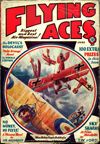 THE early spring of ‘17 saw Richthofen, the Red Knight of Germany, with almost two-score victories to his credit. For months now, hunter that he was, he had carefully searched the skies for his victims, and steadily built up a record that had already made him leading ace of the German Air Force and air idol of the German public. He had seen several months of duty as an observer at the Front, but it was under the guidance of the famous Boelcke that he started his career as a fighting pilot.
THE early spring of ‘17 saw Richthofen, the Red Knight of Germany, with almost two-score victories to his credit. For months now, hunter that he was, he had carefully searched the skies for his victims, and steadily built up a record that had already made him leading ace of the German Air Force and air idol of the German public. He had seen several months of duty as an observer at the Front, but it was under the guidance of the famous Boelcke that he started his career as a fighting pilot.
Now at last he was able to satisfy the impulse of the hunter which had always been a part of him. A deadly shot, and an expert flyer, he would climb into the clouds and there stalk his prey as carefully as he did the wild game on his own estate, waiting patiently his opportunity to dive headlong at some unsuspecting “bit of cold meat.”
This same spring there landed in a British airdrome on the Western Front a young pilot fresh from the training fields of England. He, too, had already done some four months of duty at the Front as an observer, but without getting the opportunity even to fire a shot. This lad of twenty-three was Lieutenant William Bishop, R.F.C., without a fight to his record, though he was destined in the next few months to pack in more air scraps than any other pilot in a similar length of time. He was, in these same few months, to became the dread of the Germans, the ranking ace of the R.F.C.—to barely escape death time after time, and rise to the rank of major.
He had been at the Front scarcely two weeks when he got his first German, while another two weeks saw him the proud possessor of a bright blue propeller hub-cap, presented to him by his mechanics upon his becoming an ace.
April the thirtieth was a red-letter day for both Bishop and Richthofen, though other days showed larger scores against the enemy for each of them. On this day, Bishop, in one hour and forty-five minutes, before lunch, had the distinction of engaging, single-handed, in nine separate aerial combats, bringing down a two-seater to add to his score, while Richthofen, before his noonday meal, by shooting down two of the enemy, had raised his score to fifty-two planes.
Seated as they were in their respective messes, it is questionable if either Bishop or Richthofen gave a thought one to the other, in fact, it is almost certain that Richthofen had never even heard the name of Bishop. However, fate that afternoon was to bring these two against each other.
It was about two in the afternoon, when Bishop, accompanied by his major, who was flying in another Nieuport, took off from his airport. For almost half an hour they flew steadily eastward without seeing any signs of the enemy; then, noticing some archie fire off to the left, they turned to investigate. Off some distance and below them they saw a German reconnaissance plane, and started the attack, when suddenly, darting in from their right, came four scarlet-nosed Albatross scouts.
SWINGING to avoid the first dive of the enemy, the two Britishers turned back into the battle. The major, with guns blazing, bore down upon the leader of the Germans, who, reversing quickly, avoided the direct fire of the major, and in turn attacked Bishop. It was then that Bishop realized that this plane was solid red, crimson from nose to tail save only for the black crosses standing out strongly in contrast on the wings. It was Richthofen, diving at him, trying to get him full in line with those deadly guns which had meant death to so many Englishmen. Well Bishop knew that only a split second now separated him from death.
Automatically he threw his stick over, and the plane banked up just in time, as Richthofen’s tracers went wild. Then began the tail-chasing. Around and around they swung, striving desperately to gain that deadly position behind the other’s flippers. Moments came when one or the other, by some quick maneuver, would, for the fraction of a second, find his target in line with his sights.
A burst of flames as the guns spat, but to no avail, and the chase began again.
The major had drifted off to the left, scrapping it out with one of the other Germans. This left two others, beside Richthofen, in this mad fight with Bishop. They, too, fought for a position from which they might fire upon the Britisher without endangering their own comrade and leader.
The circles were now getting tighter and tighter. The pace was terrific, and the other planes, unable to help their comrade, and fearing collision, had withdrawn to the side. Alone, the two masters of the air fought on. Each, finding himself unable to obtain the desired dead spot, was now firing with more abandon, hoping that one stray bullet might find its mark and bring this whirling dance of death to an end. For those two, time had ceased. The world was just themselves, rushing through endless space, madly circling, instinctively using every maneuver, every bit of skill at their command, to gain the desired opening.
They flew now as part of their own machines, and their guns, as part of themselves, spoke, when, for even the barest fraction of a second, their target flashed by.
Suddenly Bishop realized that he was near the end of his ammunition. He could not be sure that his opponent faced the same situation, and decided that he must conserve the few bullets that he had left. His feeling of desperation turned almost to despair, when, at this instant, he discovered three planes diving steeply at him.
Back he pulled on his stick, climbing sharply out of the mad circle, expecting every instant to feel the German bullets begin to spatter his plane, but knowing that he must take this hazard to get away from the new attack.
However, to his surprise, the planes dived past him, and down after the Red Knight, who had headed toward his two companions and Germany. Then Bishop discovered to his relief that the three planes were not Germans, as he had thought, but were three British naval planes which had come up opportunely at this moment.
The fight was over. One of the great air battles of the war was a thing of the past. The sportsman and the hunter had fought to a draw and retired with honor, each to fight many times again for his country, but never again against each other. For yet another year Richthofen continued his victories until he fell with an enemy bullet through his heart, to be buried with full military honors by his admiring foes.
Bishop fought steadily for six more months until, with forty-nine victories, he returned to his homeland, to receive every honor that a grateful king and country could bestow. He survived the war and is today the only living man with a V.C., D.S.O. twice awarded, and M.C.

“When Bishop Fought Richthofenâ€
Flying Aces, June 1932 by Paul Bissell





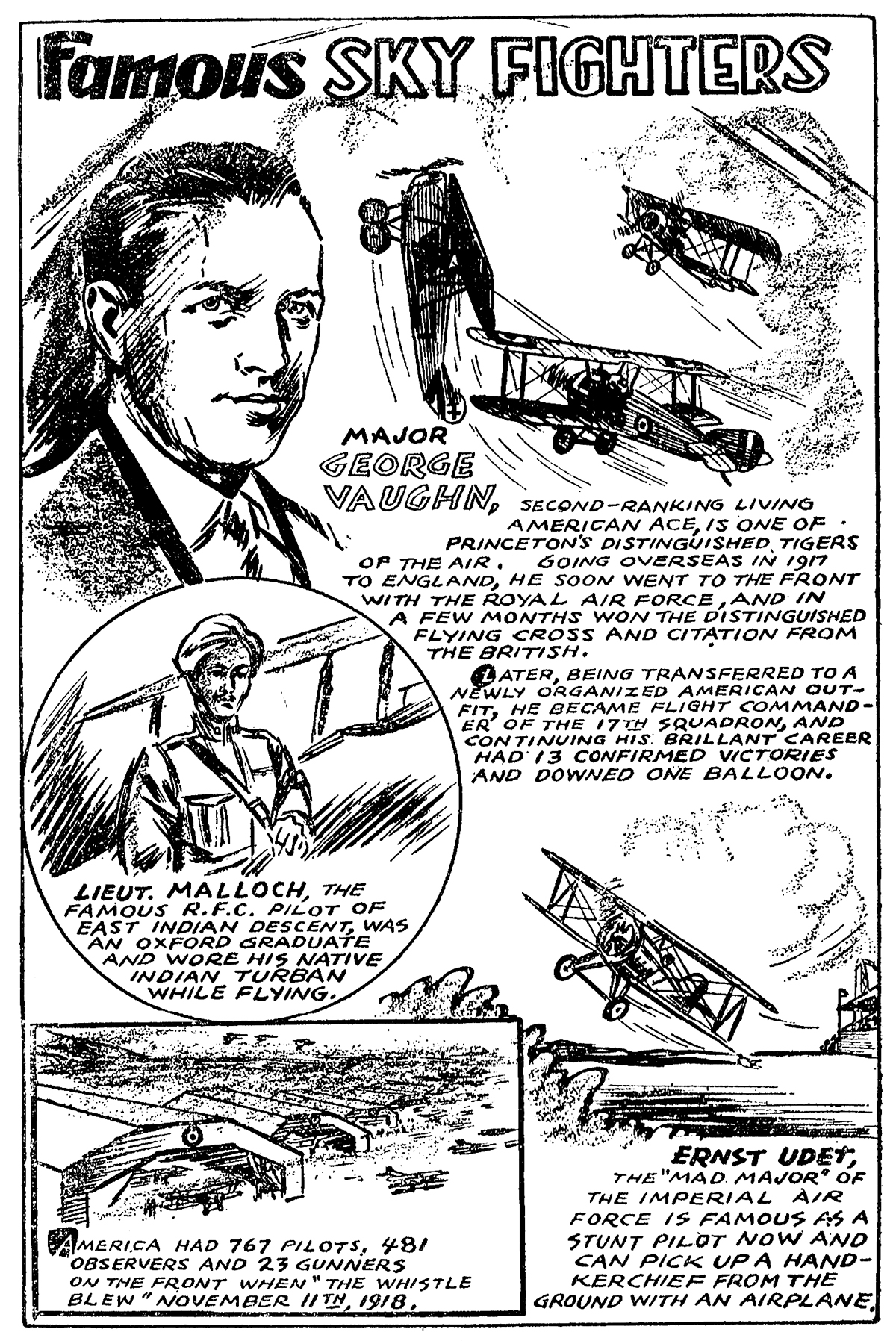
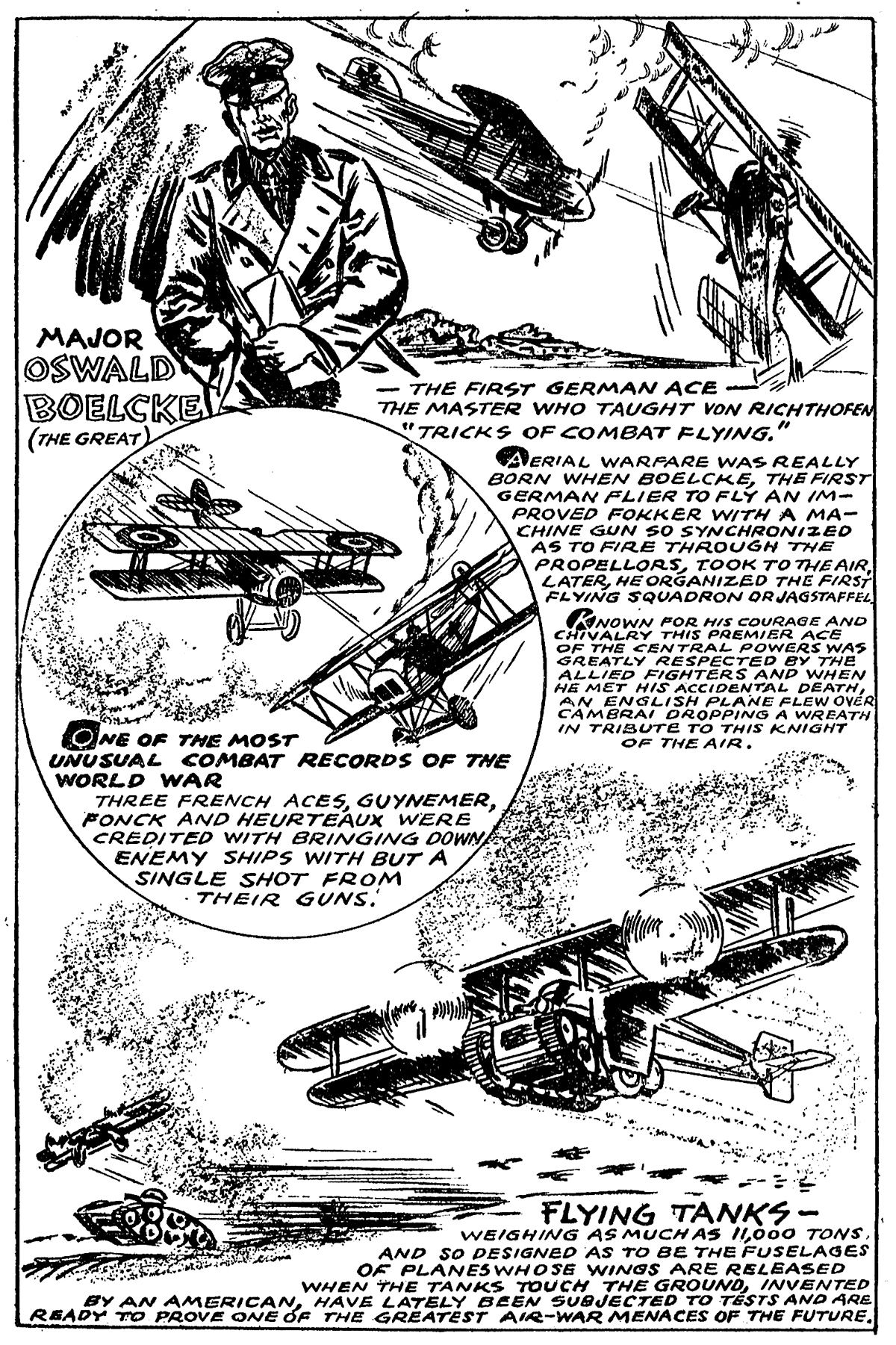
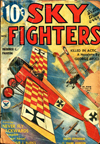
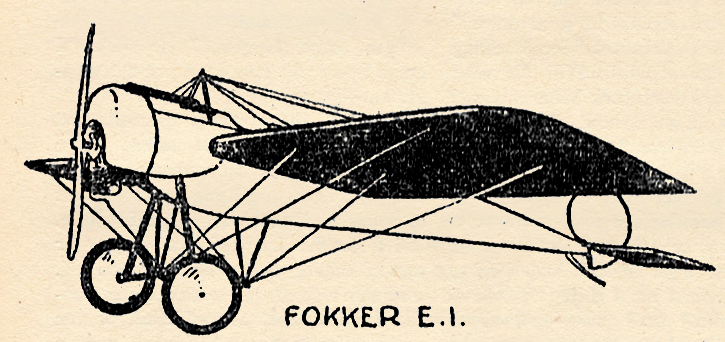
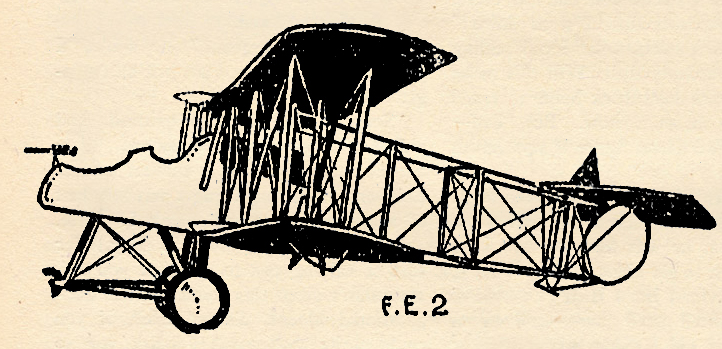
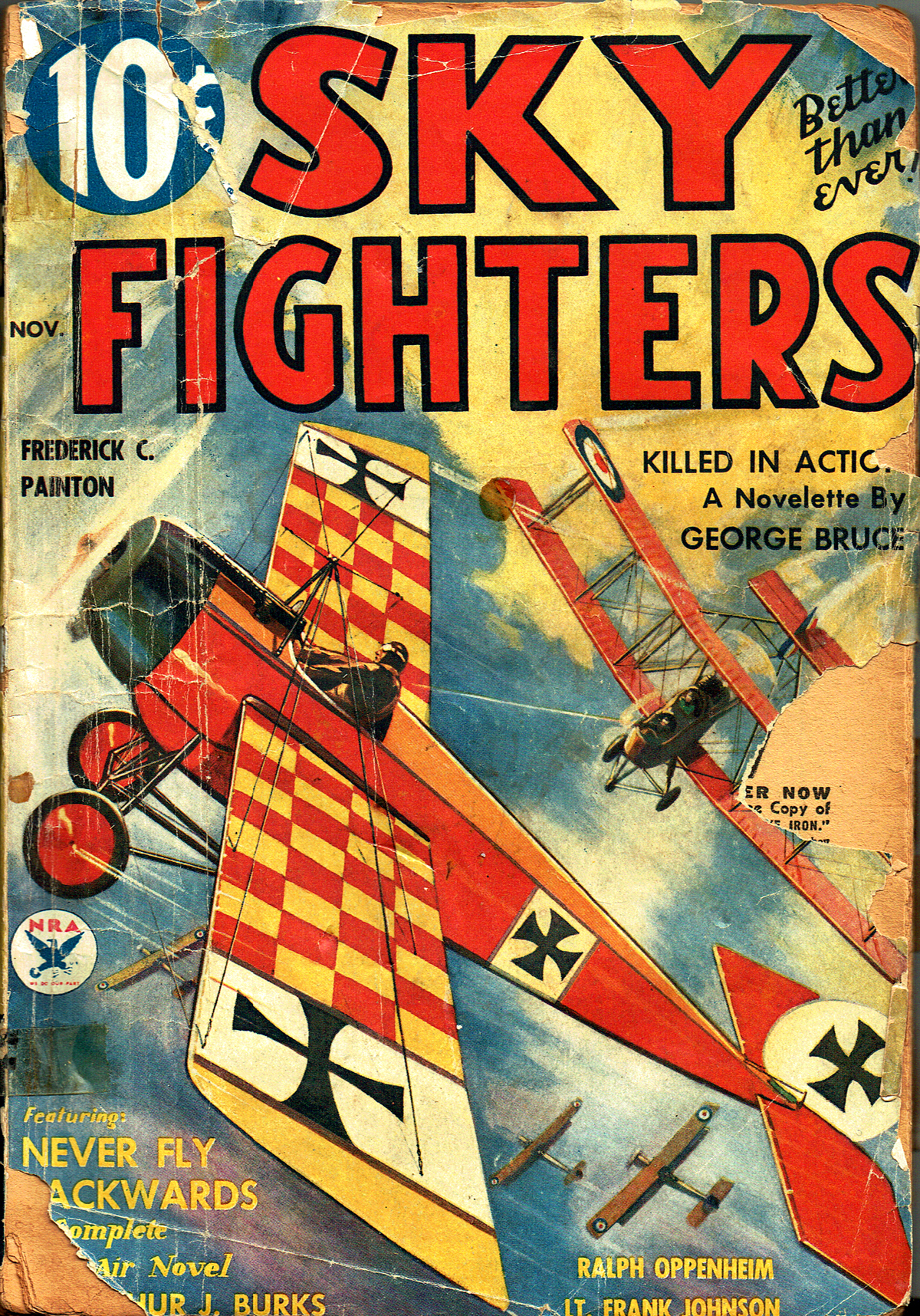
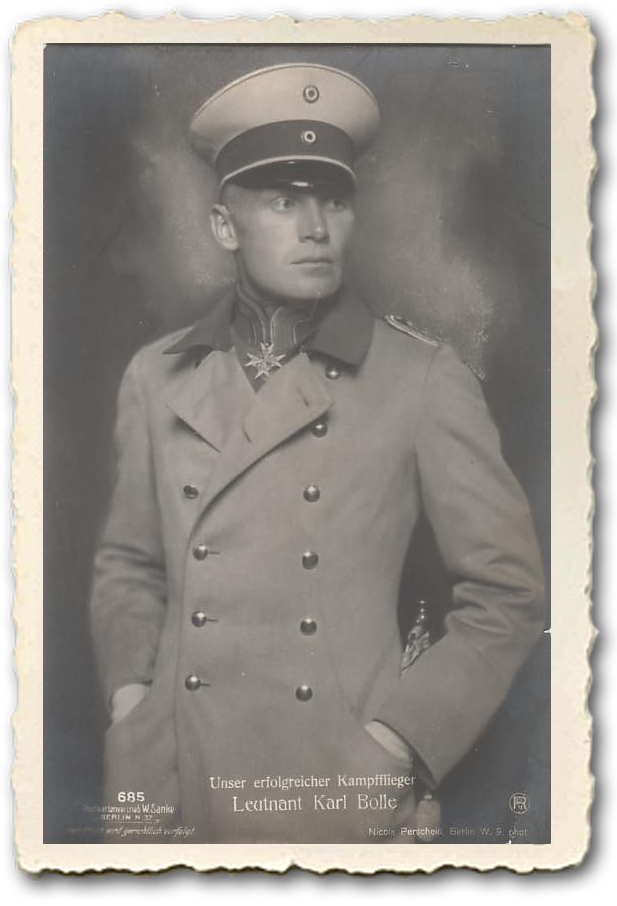 of
of